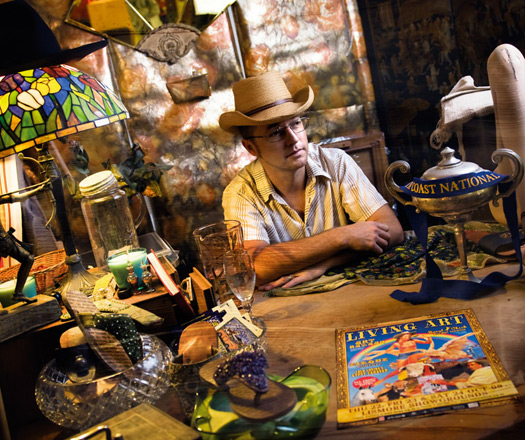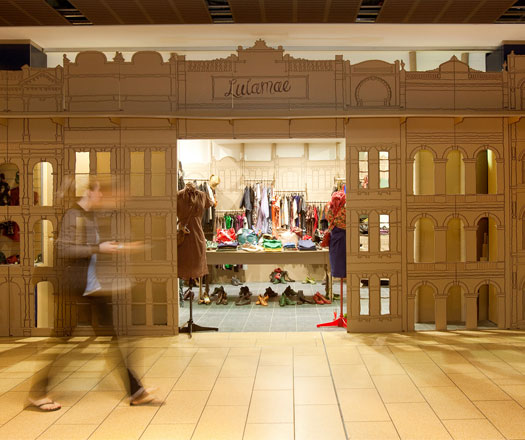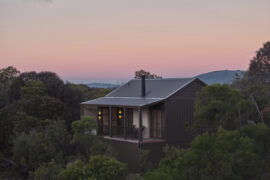The future could see transient city centres in constant flux.
July 1st, 2010
With local governments and big retail brands jumping on the bandwagon, pop-up architecture is going mainstream.
But that could lead to transient cities constantly on the move, according to Breathe Architecture’s Jeremy McLeod.
Arts NSW this month launched a website to encourage local communities to convert empty workplaces into temporary art spaces.
The concept was developed from Renew Newcastle, an urban renewal project that transformed 20 disused buildings in Newcastle’s CBD into a series of galleries and studios where artists can create, exhibit and sell their work.
Local councils in Lismore, Parramatta, the Central West, Leichhardt, Wollongong and Gosford have all expressed interest in the pop up idea.
“There’s no doubt that pop up is becoming more mainstream,” McLeod told Indesignlive.com. “Opening a pop up space does feel temporary and urban, and big retailers and local councils are keen to harness that sense of festival.”
As the trend for pop up takes off in smaller cities and previously disused areas are reinvigorated with temporal creative centres, artistic hubs and the buzz of retail, city centres themselves could become transitory in a way that is both “impermanent and exciting”, McLeod said.
“I can see how, especially in smaller cities such as Newcastle, a trend for pop up could really have an impact,” he said.
“The onus is on the designer to be clever and make use of what is there sustainably. Without a strong emphasis on reuse, the whole concept of pop up is an environmental disaster.”
McLeod and the team at Breathe Architecture created a sustainable pop up store for Melbourne fashion boutique Lulamae last year.
The store, which appeared at Melbourne Central, was constructed entirely of recycled cardboard, which was flat packed and pre cut.
“Lulamae had always been an boutique brand with a strong sense of individuality, so they really wanted to assert their independence within the big retail space,” he said.
“Clever pop up gives something back to the shopper, it’s got to be low budget to create, because of its temporary nature, without feeling cut price.”
Empty Spaces
emptyspaces.culturemap.org.au
Breathe
breathe.com.au
Photography by Trevor Worden


INDESIGN is on instagram
Follow @indesignlive
A searchable and comprehensive guide for specifying leading products and their suppliers
Keep up to date with the latest and greatest from our industry BFF's!

Welcomed to the Australian design scene in 2024, Kokuyo is set to redefine collaboration, bringing its unique blend of colour and function to individuals and corporations, designed to be used Any Way!

A curated exhibition in Frederiksstaden captures the spirit of Australian design

London-based design duo Raw Edges have joined forces with Established & Sons and Tongue & Groove to introduce Wall to Wall – a hand-stained, “living collection” that transforms parquet flooring into a canvas of colour, pattern, and possibility.
The Housing Industry Association (HIA) will convene the State of the Industry Roundtable at Parliament House in Canberra on Tuesday, against the backdrop of the worst conditions the residential construction industry has faced in decades. “Residential construction is experiencing its second recession in four years,” said HIA Managing Director, Mr Shane Goodwin today. “There are […]
On the eve of the opening of The Blocks, a collaboration with Australian winery Penfolds and her first installation outside Europe, interior stylist and designer Faye Toogood spoke to Indesignlive about her inspiration behind the concept, her favourite collaborations and what informs her work.
The internet never sleeps! Here's the stuff you might have missed

In what is already a peaceful idyll on the Mornington Peninsula, Kate Walker has crafted an intimate retreat with new villas for overnight stays at Alba.

Sub-Zero Wolf Kitchen Design Contest (KDC) announces the remarkable Arizona Biltmore as the location of the 2026 Gala Venue and Winners’ Summit